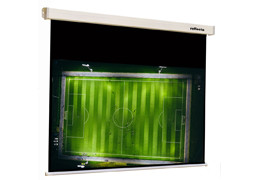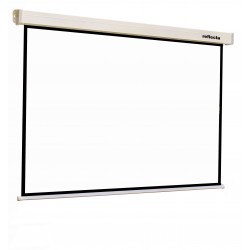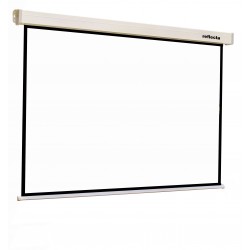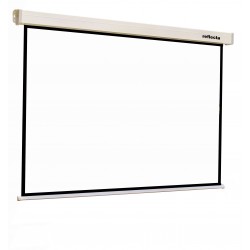The perfect solution for your home cinema

Manual roller projection screens
Choosing the right projection screen is an important step in designing your home theater experience or conference room. A popular option in this regard is the manual roller projection screen. In this blog post we will take a closer look at the advantages and disadvantages of this classic screen solution.
The advantages of manual roller projection screens:
Cost-effective:
One of the most noticeable advantages of manual roller projection screens is their cost-effective purchase. They are typically much more affordable than electric or fixed screens. This makes them an attractive option for budget-oriented buyers.
Easy installation:
Installing a manual roller projection screen is straightforward and does not require professional help. As a rule, you can mount them yourself on the desired wall or ceiling.
No power source required:
Unlike electric screens, manual roller screens do not require a power supply. This can be particularly useful in rooms where there is no outlet nearby or if you want to avoid wiring.
Longevity:
Due to their simple construction, manual roller screens are often durable and less prone to technical problems compared to electric screens.
The disadvantages of manual roller blind canvases:
Manual operation:
The most obvious disadvantage is the manual operation. To lower or roll up the screen, you must do it by hand. This can be awkward and requires physical effort.
Time consuming:
Lowering and rolling up the screen can be time-consuming, especially in large rooms. This can be annoying if you want to quickly start your presentation or movie night.
Limited positioning options:
Manual roller blind screens often offer limited positioning options. They can usually only be installed at a fixed height and are not as flexible as some other screen types.
Less comfort:
Compared to electric screens, manual roller screens offer less convenience. You have to stand up or move to operate the screen, which can be inconvenient in some situations.
Conclusion:
Manual roller screens are a budget-friendly option for those looking for an easy and affordable way to enhance their home theater or presentation experience. Their easy installation and maintenance, their independence from a power source and their durability are clear advantages. However, you must be aware that they require some manual work and have some limitations in terms of positioning and comfort. Your choice ultimately depends on your individual needs, budget, and willingness to operate manually.
Related products
-
reflecta Spring rollo screen 125x125 cm with stop mechanism
Old price: €49.90 Price: €26.90 Discount: 46% Save up: -€23.00Low stockThe proven and reliable reflecta spring roller system offers high... -
reflecta Spring rollo screen 153x153 cm with stop mechanism
Old price: €67.90 Price: €35.90 Discount: 47% Save up: -€32.00AvailabilityThe proven and reliable reflecta spring roller system offers high... -
reflecta CrystalLine Rollo 160x160 cm 1:1
Old price: €87.90 Price: €78.90 Discount: 10% Save up: -€9.00AvailabilityThe reflecta CrystalLine self-locking roller projection screens are extremely... -
reflecta CrystalLine Rollo 180x180 cm 1:1
Old price: €92.90 Price: €82.90 Discount: 11% Save up: -€10.00AvailabilityThe reflecta CrystalLine self-locking roller projection screens are extremely... -
reflecta CrystalLine Rollo 200x200 cm 1:1
Old price: €103.00 Price: €92.00 Discount: 11% Save up: -€11.00AvailabilityThe reflecta CrystalLine self-locking roller projection screens are extremely... -
reflecta CrystalLine Rollo 240x240 cm 1:1
Old price: €135.00 Price: €121.00 Discount: 10% Save up: -€14.00AvailabilityThe reflecta CrystalLine self-locking roller projection screens are extremely... -
reflecta CrystalLine Rollo 300x300 cm 1:1
Old price: €258.00 Price: €232.00 Discount: 10% Save up: -€26.00AvailabilityThe reflecta CrystalLine self-locking roller projection screens are extremely... -
reflecta CrystalLine Rollo 160x129 (156x117) cm 4:3
Old price: €87.90 Price: €78.90 Discount: 10% Save up: -€9.00AvailabilityThe reflecta CrystalLine self-locking roller projection screens are extremely... -
reflecta CrystalLine Rollo 180x144 (176x132) cm 4:3
Old price: €92.90 Price: €82.90 Discount: 11% Save up: -€10.00AvailabilityThe reflecta CrystalLine self-locking roller projection screens are extremely... -
reflecta CrystalLine Rollo 200x159 (196x147) cm 4:3
Old price: €103.00 Price: €92.00 Discount: 11% Save up: -€11.00AvailabilityThe reflecta CrystalLine self-locking roller projection screens are extremely... -
reflecta CrystalLine Rollo 220x174 (216x162) cm 4:3
Old price: €111.00 Price: €99.00 Discount: 11% Save up: -€12.00AvailabilityThe reflecta CrystalLine self-locking roller projection screens are extremely... -
reflecta CrystalLine Rollo 240x189 (236x177) cm 4:3
Old price: €135.00 Price: €121.00 Discount: 10% Save up: -€14.00AvailabilityThe reflecta CrystalLine self-locking roller projection screens are extremely... -
reflecta CrystalLine Rollo 300x233 (292x219) cm 4:3
Old price: €258.00 Price: €232.00 Discount: 10% Save up: -€26.00AvailabilityThe reflecta CrystalLine self-locking roller projection screens are extremely... -
reflecta CrystalLine Rollo 160x130 (156x88) cm 16:9
Old price: €87.90 Price: €78.90 Discount: 10% Save up: -€9.00AvailabilityThe reflecta CrystalLine self-locking roller projection screens are extremely... -
reflecta CrystalLine Rollo 180x141 (176x99) cm 16:9
Old price: €92.90 Price: €82.90 Discount: 11% Save up: -€10.00AvailabilityThe reflecta CrystalLine self-locking roller projection screens are extremely... -
reflecta CrystalLine Rollo 200x152 (196x110) cm 16:9
Old price: €103.00 Price: €92.00 Discount: 11% Save up: -€11.00AvailabilityThe reflecta CrystalLine self-locking roller projection screens are extremely... -
reflecta CrystalLine Rollo 240x175 (236x133) cm 16:9
Old price: €135.00 Price: €121.00 Discount: 10% Save up: -€14.00AvailabilityThe reflecta CrystalLine self-locking roller projection screens are extremely... -
reflecta CrystalLine Rollo 300x208 (292x164) cm 16:9
Old price: €258.00 Price: €232.00 Discount: 10% Save up: -€26.00AvailabilityThe reflecta CrystalLine self-locking roller projection screens are extremely... -
reflecta CrystalLine Rollo 180x141 (174x108) cm 16:10
Old price: €92.90 Price: €82.90 Discount: 11% Save up: -€10.00AvailabilityThe reflecta CrystalLine self-locking roller projection screens are extremely... -
reflecta CrystalLine Rollo 200x154 (196x121) cm 16:10
Old price: €103.00 Price: €92.00 Discount: 11% Save up: -€11.00AvailabilityThe reflecta CrystalLine self-locking roller projection screens are extremely... -
reflecta CrystalLine Rollo 240x179 (234x146) cm 16:10
Old price: €135.00 Price: €121.00 Discount: 10% Save up: -€14.00AvailabilityThe reflecta CrystalLine self-locking roller projection screens are extremely... -
reflecta CrystalLine Rollo 300x226 (290x181) cm 16:10
Old price: €258.00 Price: €232.00 Discount: 10% Save up: -€26.00AvailabilityThe reflecta CrystalLine self-locking roller projection screens are extremely... -
reflecta CrystalLine Rollo Softlift 160x160 cm 1:1
Old price: €90.90 Price: €80.90 Discount: 11% Save up: -€10.00AvailabilityThe reflecta CrystalLine self-locking roller projection screens are extremely... -
reflecta CrystalLine Rollo Softlift 180x180 cm 1:1
Old price: €94.90 Price: €84.90 Discount: 11% Save up: -€10.00AvailabilityThe reflecta CrystalLine self-locking roller projection screens are extremely... -
reflecta CrystalLine Rollo SoftLift 200x200 cm 1:1
Old price: €107.00 Price: €96.00 Discount: 10% Save up: -€11.00AvailabilityThe reflecta CrystalLine self-locking roller projection screens are extremely... -
reflecta CrystalLine Rollo Softlift 240x240 cm 1:1
Old price: €137.00 Price: €123.00 Discount: 10% Save up: -€14.00AvailabilityThe reflecta CrystalLine self-locking roller projection screens are extremely... -
reflecta CrystalLine Rollo Softlift 200x159 (196x147) cm 4:3
Old price: €109.00 Price: €98.00 Discount: 10% Save up: -€11.00AvailabilityThe reflecta CrystalLine self-locking roller projection screens are extremely... -
reflecta CrystalLine Rollo Softlift 220x174 (216x162) cm 4:3
Old price: €115.00 Price: €103.00 Discount: 10% Save up: -€12.00AvailabilityThe reflecta CrystalLine self-locking roller projection screens are extremely... -
reflecta Rollo SilverLine 155x149 (145x109) cm 4:3
Old price: €81.90 Price: €44.90 Discount: 45% Save up: -€37.00Low stockThe reflecta large projection screen to be fixed permanently to a wall or... -
reflecta Rollo SilverLine 180x168 (170x128) cm 4:3
Old price: €94.90 Price: €51.90 Discount: 45% Save up: -€43.00Low stockThe reflecta large projection screen to be fixed permanently to a wall or... -
reflecta Rollo Galaxy 213x215 (203x203) cm 1:1
Old price: €280.00 Price: €154.00 Discount: 45% Save up: -€126.00Low stockThe rectractable projection screen is installed in a profiled sheetmetal case... -
reflecta Rollo Galaxy 213x186 (203x152) cm 4:3
Old price: €163.00 Price: €89.90 Discount: 45% Save up: -€73.10AvailabilityThe rectractable projection screen is installed in a profiled sheetmetal case... -
reflecta Rollo Galaxy 231x179 (221x125) cm 16:9
Old price: €280.00 Price: €154.00 Discount: 45% Save up: -€126.00Low stockThe rectractable projection screen is installed in a profiled sheetmetal case...
Related posts
-
 The world of projection screens
Posted in: Projection screens01.11.20232 LikedStationary screens vs. mobile screensRead more
The world of projection screens
Posted in: Projection screens01.11.20232 LikedStationary screens vs. mobile screensRead more -
 Motorized screens
Posted in: Projection screens02.02.20243 LikedComfort and technology for your home cinemaRead more
Motorized screens
Posted in: Projection screens02.02.20243 LikedComfort and technology for your home cinemaRead more -
 In-ceiling installation of screens in suspended ceilings
Posted in: Projection screens01.03.20243 LikedThe advantages and disadvantages of projection screens for installation in suspended ceilingsRead more
In-ceiling installation of screens in suspended ceilings
Posted in: Projection screens01.03.20243 LikedThe advantages and disadvantages of projection screens for installation in suspended ceilingsRead more -
 Framed screens for wall mounting
Posted in: Projection screens02.04.20242 LikedThe perfect solution for your home cinemaRead more
Framed screens for wall mounting
Posted in: Projection screens02.04.20242 LikedThe perfect solution for your home cinemaRead more






































